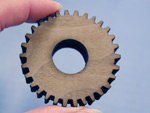26 March 2010
Laser cutting wood with the Firestar f400
 Many industrial laser processes involve cutting, marking, drilling, or welding various steel or plastic materials. However, products manufactured from wood are also ideal candidates for CO2 laser processing. Some of these applications include creating complex hardwood puzzle pieces, precisely grooving birch or maple dieboard for die cutting operations, and cutting out the intricate balsa wood components used in model kits.
Many industrial laser processes involve cutting, marking, drilling, or welding various steel or plastic materials. However, products manufactured from wood are also ideal candidates for CO2 laser processing. Some of these applications include creating complex hardwood puzzle pieces, precisely grooving birch or maple dieboard for die cutting operations, and cutting out the intricate balsa wood components used in model kits.
Because laser cutting wood is a chemical degradation process (where the wood fibre is burned away and removed from the cut area by pressurized assist gas), cut edges are usually charred at the surface, but little to no discoloration is seen on adjoining faces.
The largest problem when cutting wood by any method is moisture content and density - dry, lightweight woods cut easily while dense or moisture-laden woods cut more slowly. For laser cutting operations, consistent storage conditions and moisture control procedures are crucial to obtaining repeatable results.
To illustrate the capability of the Synrad Firestar f400 laser, this gear shape was cut from a piece of 12.7 mm (0.50") thick walnut hardwood. The setup consisted of an XY "flying optics" cutting head equipped with a 63.5 mm (2.5") positive meniscus lens that provides a 100-micron (0.004") focused spot and a 1.8 mm (0.07") depth of focus. Pressurised air assist, at 2.07 bar (30 PSI) was supplied through the nozzle to the work surface.
Using 400 watts of power, the pattern shown was cut at a rate of 2.16 metres per minute (85 in/min) in a cycle time of 29 seconds. Although the laser-cut tooth faces exhibit some surface charring, both top and bottom surfaces are clean and free of discoloration.
- Contact Information
- Name: Gary Broadhead
- Email: garyb@laserlines.co.uk
- Website: www.laserlines.co.uk

